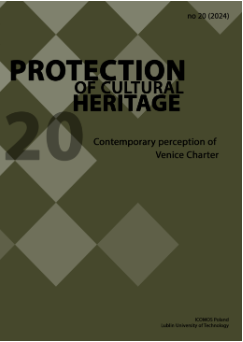Konserwacja miejska w kartach międzynarodowych
Od Karty Ateńskiej do Rekomendacji dotyczącej Historycznego Krajobrazu Miejskiego
Ruxandra-Iulia Stoica
r.stoica@ed.ac.ukThe University of Edinburgh (Wielka Brytania)
https://orcid.org/0000-0002-3096-0761
Abstrakt
W niniejszym artykule przedstawiony zostanie analityczny przegląd tekstów doktrynalnych, które miały kluczowe znaczenie dla kształtowania zintegrowanej praktyki konserwacji urbanistycznej na arenie międzynarodowej: od Karty Ateńskiej do Konwencji dotyczącej Historycznego Krajobrazu Miejskiego.
Karta Ateńska z 1931 roku dotycząca restauracji zabytków została opublikowana w tym samym czasie, kiedy Międzynarodowy Kongres Architektury Nowoczesnej podsumowywał swoją kontrowersyjną ideologię urbanistyczną w Karcie Ateńskiej z 1933 roku. Podczas gdy Karta Ateńska skupiała się na technicznych aspektach renowacji zabytków, poprzedzająca ją debata wskazywała na rosnące zainteresowanie historycznymi obszarami miejskimi. Również Karta CIAM, mimo że zawierała sekcję dotyczącą historycznych obszarów miejskich, ograniczała swoje zalecenia do ochrony pojedynczych zabytków lub zespołów.
W latach 60-tych i 70-tych XX wieku, pierwsze krajowe ustawodawstwo i międzynarodowe karty skierowane specjalnie do obszarów miejskich, poprzedzone zostały poważnymi badaniami historycznych centrów w krajach europejskich. W szczególności Międzynarodowa Karta Wenecka z 1964 r. dotycząca konserwacji i restauracji zabytków i miejsc ostatecznie rozszerzyła koncepcje restauracji i rehabilitacji zabytków na obszary chronione, takie jak historyczne centra miast, zalecając rozszerzenie prawodawstwa dotyczącego ochrony dziedzictwa na całym świecie. Europejskie ustawodawstwo krajowe poszło za tym przykładem. W 1975 roku, podczas Europejskiego Roku Dziedzictwa Architektonicznego, wydano również pierwszą kartę promującą ochronę historycznego środowiska architektonicznego jako całości.
Jednak pod koniec XX wieku, pomimo przyjęcia na arenie międzynarodowej dużej liczby kolejnych tekstów doktrynalnych oraz publikacji licznych książek, artykułów i raportów poruszających problematykę konserwacji urbanistycznej, niedostatek teoretycznego i koncepcyjnego postępu w tej dziedzinie pozostał oczywisty. Opóźnienie w nadaniu solidnej struktury teoretycznej dziedzinie konserwacji urbanistycznej wynikało, co całkiem zrozumiałe, ze złożoności środowiska miejskiego i wynikającej z tego trudności w oddzieleniu efektów różnych zmiennych w nim działających.
Karty z ostatnich trzech dekad wzywają do integracji planowania i konserwacji urbanistycznej w oparciu o ocenę historycznej tkanki miejskiej i jej społeczności, podejście, które powinno ostatecznie zapewnić bardziej zrównoważony rozwój miejski. Oznacza to, z jednej strony, zrozumienie i ocenę znaczenia miejsca, a z drugiej strony, nakreślenie implikacji dla zarządzania w celu ochrony tego znaczenia i identyfikacji możliwości zmian. Zalecenia dotyczące historycznego krajobrazu miejskiego z 2011 r. w pewien sposób umiędzynarodawiają teorię i praktykę, która do tej pory była rozwijana głównie w kontekście europejskim.
Istnieje wiele kwestii, które zostały poruszone w kartach w ciągu ostatnich stu lat, a wiele z nich nadal potrzebuje odpowiednich ram teoretycznych, które pozwolą na ich szerokie zastosowanie w praktyce, poza miejscami o silnych tradycjach ochrony dziedzictwa i ustawodawstwie.
Słowa kluczowe:
miejski, dziedzictwo, konserwacja, międzynarodowy, europejski, kartyBibliografia
Choay F., L’Allégorie du patrimoine (Paris: Editions du Seuil, 1992), 126.
Google Scholar
Jokilehto J., A History of Architectural Conservation (Oxford, Auckland, Boston, Johannesburg, Melbourne, New Delhi: Butterworth-Heinemann, 1999), 285.
Google Scholar
Siewert P., “The Ephebic Oath in Fifth-Century Athens Source,” The Journal of Hellenic Studies, Vol. 97 (1977): 102-111, http://www.jstor.org/stable/631025 (Accessed: 10/07/2010).
DOI: https://doi.org/10.2307/631025
Google Scholar
Sitte C., Der Städtebau nach seinen künstlerischen Grundsätzen (Vienna, 1889).
Google Scholar
Carta di Gubbio: Dichiarazione finale approvata all’unanimità a conclusione del Convegno Nazionale per la Salvaguardia e il Risanamento dei Centri Storici, 1960.UNESCO Recommendation Concerning the Safeguarding of the Beauty and Character of Landscapes and Sites, 1962.
Google Scholar
CE Amsterdam Declaration of the Congress on the European Architectural Heritage, 1975
Google Scholar
Conservation and rehabilitation of the historical and cultural heritage, Habitat Agenda, http://www.unhabitat.org (accessed 30 December 2008), 67-8.
Google Scholar
ICOMOS Washington Charter on the Conservation of Historic Towns and Urban Areas, 1987.
Google Scholar
UNESCO Nairobi Recommendation concerning the Safeguarding and Contemporary Role of Historic Areas, 1976.
Google Scholar
Venice International Charter for the Conservation and Restoration of Monuments and Sites, 1964.
Google Scholar
Autorzy
Ruxandra-Iulia Stoicar.stoica@ed.ac.uk
The University of Edinburgh Wielka Brytania
https://orcid.org/0000-0002-3096-0761
Statystyki
Abstract views: 425PDF downloads: 307
Licencja

Utwór dostępny jest na licencji Creative Commons Uznanie autorstwa – Na tych samych warunkach 4.0 Miedzynarodowe.








